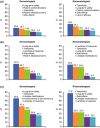Physician perspectives in the management of psoriasis and psoriatic arthritis: results from the population-based Multinational Assessment of Psoriasis and Psoriatic Arthritis survey
- PMID: 25885420
- PMCID: PMC5029592
- DOI: 10.1111/jdv.13150
Physician perspectives in the management of psoriasis and psoriatic arthritis: results from the population-based Multinational Assessment of Psoriasis and Psoriatic Arthritis survey
Abstract
Background: Available literature on psoriasis and psoriatic arthritis (PsA) demonstrates a tremendous burden of disease and suggests underdiagnosis and undertreatment.
Objective: To obtain real-world physician perspectives on the impact of psoriasis and PsA and its treatment on patients' daily lives, including perceptions of, and satisfaction with, current therapies.
Methods: The Multinational Assessment of Psoriasis and Psoriatic Arthritis (MAPP) surveyed dermatologists (n = 391) and rheumatologists (n = 390) in North America (Canada and the United States) and Europe (France, Germany, Italy, Spain and United Kingdom).
Results: Dermatologists classified 20.3% and 25.7% of their patients as having severe psoriasis and severe PsA respectively; rheumatologists indicated that 48.4% of their PsA patients had active disease. Of the psoriasis patients complaining of joint pain, only 33.0% had a diagnosis of PsA. An impact on daily activities or social/emotional well-being was recognized by 57.2% to 79.3% of physicians. In patients with moderate-to-severe psoriasis, dermatologists reported 74.9% were receiving topical therapy, 19.5% conventional oral therapy and 19.6% biologics. Dermatologists and rheumatologists reported similar rates of topical (≈45%) and biologic (≈30%) therapy utilization for their PsA patients; conventional oral therapy was more often prescribed by rheumatologists (63.4%) vs. dermatologists (35.2%). Reasons for not initiating or maintaining systemic therapies were related to concerns about long-term safety, tolerability, efficacy and costs (biologics).
Conclusion: Physicians in North America and Europe caring for patients with psoriasis and PsA acknowledge unmet treatment needs, largely concerning long-term safety/tolerability and efficacy of currently available therapies; evidence suggests underdiagnosis of PsA and undertreatment of psoriasis among dermatologists.
© 2015 The Authors. Journal of the European Academy of Dermatology and Venereology published by John Wiley & Sons Ltd on behalf of European Academy of Dermatology and Venereology.
Figures





References
-
- Augustin M, Reich K, Glaeske G, Schaefer I, Radtke M. Co‐morbidity and age‐related prevalence of psoriasis: analysis of health insurance data in Germany. Acta Derm Venereol 2010; 90: 147–151. - PubMed
-
- Menter A, Gottlieb A, Feldman SR et al Guidelines of care for the management of psoriasis and psoriatic arthritis: section 1. Overview of psoriasis and guidelines of care for the treatment of psoriasis with biologics. J Am Acad Dermatol 2008; 58: 826–850. - PubMed
-
- Ferrandiz C, Bordas X, Garcia‐Patos V, Puig S, Pujol R, Smandia A. Prevalence of psoriasis in Spain (Epiderma Project: phase I). J Eur Acad Dermatol Venereol 2001; 15: 20–23. - PubMed
-
- Rachakonda TD, Schupp CW, Armstrong AW. Psoriasis prevalence among adults in the United States. J Am Acad Dermatol 2014; 70: 512–516. - PubMed
Publication types
MeSH terms
Substances
LinkOut - more resources
Full Text Sources
Other Literature Sources
Medical
Research Materials
Miscellaneous

